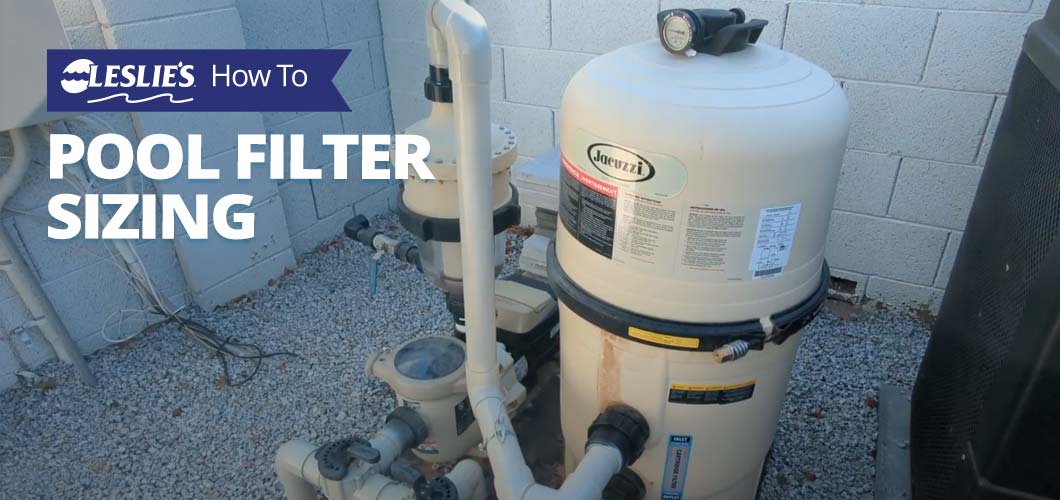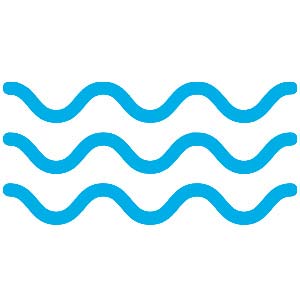
Pool Filter Sizing
Whether you're buying your first pool filter, or upgrading an old one, purchasing the right filter size and type can be daunting. Should you buy a sand filter or a cartridge filter? What size filter should you get? If these questions are swirling through your head, then you're in the right place! This post will walk you through the steps for how to select the right pool filter size and type.

Calculate Pool Volume

Determine Filter Flow Rate

Choose Filter Type

Select New Filter
1. Calculate Pool Volume
Before shopping for your new pool filter, first determine the total volume of your pool. Knowing how many gallons of water are in your pool will help you select the most compatible pool filter size. Thankfully, we've made calculating your pool volume easy! Check out our post, "How To Calculate Pool Volume", for a quick pool volume reference chart. Or, if you want to do the calculations yourself, here are a few easy formulas:
Rectangular or square pool
Length x Width x Depth x 7.5 = Pool Volume (Gallons)
Round or circular pool
3.14 × Radius2 × Depth x 7.5 = Pool Volume (Gallons)
Oval or rounded rectangle pool
3.14 x Length x Width x 0.25 x Depth x 7.5 = Pool Volume (Gallons)
Kidney-shaped pool
Measure the widest points of your kidney-shaped pool to determine the A and B width lengths, then plug them into the equation below:
(Width A + Width B) x Length x 0.45 x Depth x 7.5 = Pool Volume (Gallons
Irregular-shaped pool
For an irregularly-shaped pool, use the following formula for an approximate volume amount:
Length x Width x Depth x 5.9 = Pool Volume (Gallons)
2. Determine Pump Turnover Rate

Your pool's filter and pump work hand-in-hand, and one can't function without the other. So when looking for a new pool filter, it's vital that the filter and your current pump are compatible. Before you begin filter shopping, it's important to first determine what your pump's turnover rate is. The turnover rate of your pump is the time it takes the pump to fully circulate all the water in your pool. Typically, most pumps accomplish this in about 8–10 hours, which is the ideal amount of time you want your pump to run each day. Use this equation to determine your pump's minimum turnover rate:
Pool Volume ÷ Hours = Gallons per Hour (GPH) Turnover Rate
To find the Gallons per Minute (GPM) rate, simply divide the GPH turnover rate by 60:
GPH ÷ 60 = Gallons per Minute (GPM) Turnover Rate
3. Determine Filter Flow Rate
Now that you know your pump's turnover rate, it's time to determine what the minimum flow rate of your new filter needs to be. Just like a pump's turnover rate, a filter's flow rate is the amount of time it takes to fully circulate all the water in your pool. Knowing the flow rate is crucial to selecting the correct pool filter size, because the pump's turnover rate should always be less than the filter's flow rate. A incorrectly-sized filter won't be equipped to handle the output from the pump, which can lead to filter damage and poorly-filtered water.
Say, for example, you have a 20,000 gallon pool and your pump's turnover is 8 hours. Using the formula above, your pump has a turnover rate of 42 GPM. This rating means your pool filter must have a flow rate of at least 43 GPM.
4. Select Pool Filter Type

Once you've determined the required flow rating for your new filter, you can select what type of pool filter you want. The three main types of filters are sand, cartridge, and diatomaceous earth (D.E.). While sand filters are the most popular and affordable type, they don't filter extra tiny debris like cartridge and D.E. filters.
- Diatomaceous Earth, or D.E., filters are the most efficient type of filter. These filters use a fine white powder made of tiny, fossilized hard-shell algae called “diatom” as a filtering medium. D.E. filters are cleaned by backwashing or reversing the flow of water through the filter, or by taking the filter apart and manually cleaning or replacing the grids.
- Cartridge filters are the second most efficient filters. They use large, pleated cartridges as the filtering medium. This filter is manually cleaned by taking the filter apart and cleaning the cartridges.
- Sand filters are the least efficient of the three types of filters, but it is the most popular for certain areas of the country and in commercial pools because of the low maintenance. This filter is cleaned by backwashing or reversing the flow of water through the filter to flush out debris.
Check out our post, Pool Filter Comparison Guide, for more information on the three types of pool filters!
5. Pool Filter Size
A good rule of thumb to remember when it comes to pool filter size is that bigger is generally better. Specifically, you want the filter to be larger than the pool pump. This not only provides better filtering, but also protects the filter from overworking and being burned out by a too-powerful pump. However, it's important to make sure the filter isn't too big for the pump, as an insufficient flow rate through the filter media can cause ineffective filtration. While larger filters may be a bit pricier, they provide better filtering and easier maintenance for pool owners, among other benefits:
- Increased time between cleaning or backwashing.
- Efficient filtration of small particles.
- Increased longevity of filter media.
6. Adjust the Filter Area and Rate
Pool filter rate may be regulated in certain locations. The National Sanitation Foundation (NSF) sets the standard for filter rates to ensure effective and efficient filtration. Filter rate regulations are typically imposed with commercial pool installations, but you can compensate by selecting a filter with a larger filtration area.
7. Purchase Your New Pool Filter
Now it’s time to choose the perfect pool filter for your swimming pool! Using the information from this post, you will find the perfect pool filter size to fit the needs of your pool, and keep it clean, clear, and healthy.
Finding the right pool filter size for your pool isn't as difficult as it might seem. With just a few simple calculations, you can arm yourself with the knowledge you need to make the best purchase. Stop by your local Leslie's and speak with one of our pool experts about purchasing and installing your new pool filter. Or, schedule a service appointment online and have one of our certified technicians come out to your home.